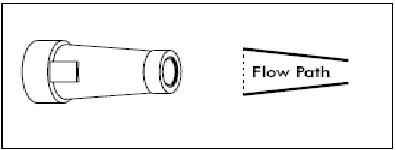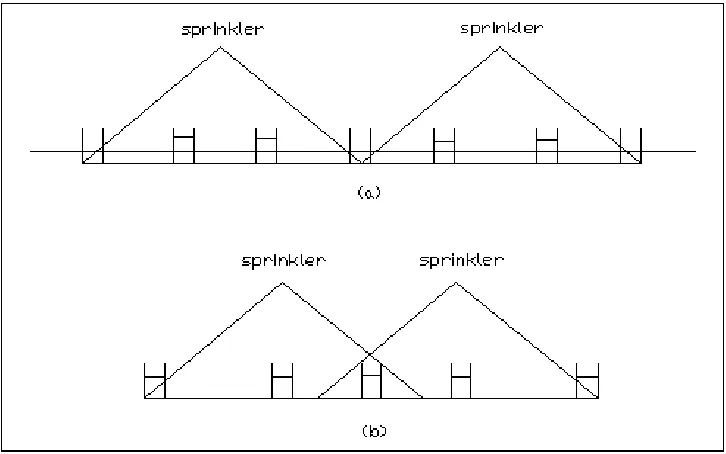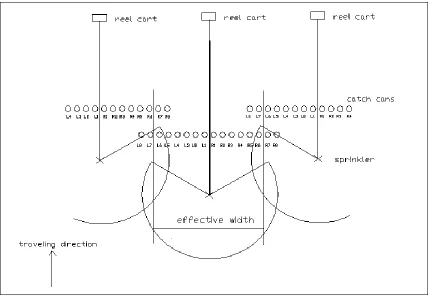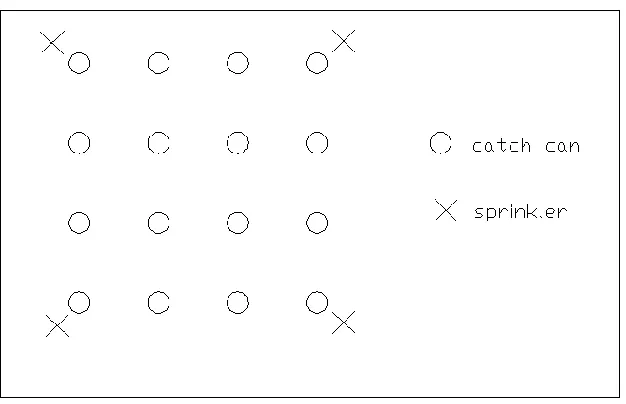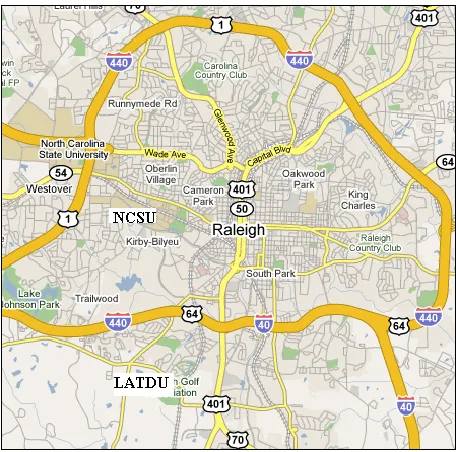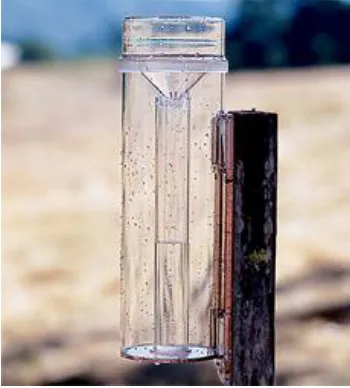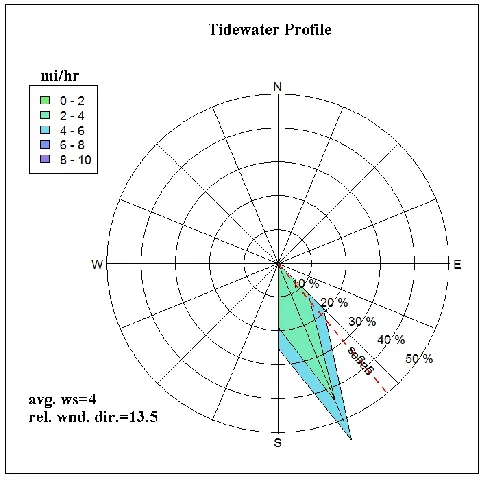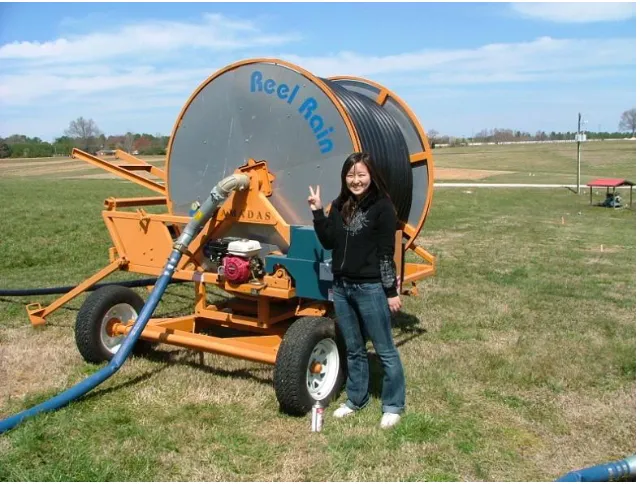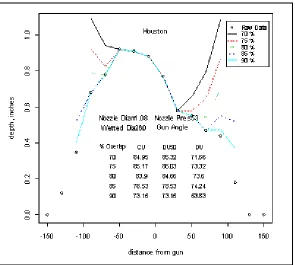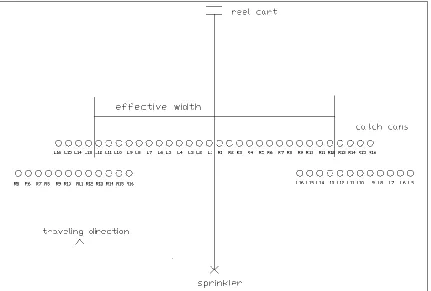ABSTRACT
LIU, ZHENGZHONG. A Rapid Assessment Tool for Determining Uniformity of Irrigation-Type Manure Application Systems. (Under the direction of Garry Grabow.)
Due to the extent of the animal industry in North Carolina, the treatment of liquid manure is
of great importance. Since liquid manure contains plant nutrients, it is usually treated through
application to agricultural land through irrigation systems as a substitute or partial substitute
for commercial fertilizer. However, land application of liquid manure needs to follow some
guidelines in order to achieve economic goals as well as to protect the environment. Current
guidance suggests calibration of land application equipment be performed once every three
years by the “catch can” method, a time- and labor-consuming method. The research goals of
this project were to investigate the relationship between liquid manure application uniformity
and application system hydraulic measurements and then make tables of the predicted
application uniformity for field use.
Trials were performed to test the manure application uniformity for different sprinkler types,
nozzle types, gun models, nozzle diameters, system types, site types, gun models, and nozzle
pressures. The wind speed and direction during the trials was monitored. Different overlaps
were achieved by superposition, thereby allowing for assessment of multiple sprinkler
overlap extents for one trial. The overlaps used for traveling gun systems reflected sprinkler
(lane) spacings of 70%, 75%, 80%, 85%, and 90% of the wetted diameter, and those used for
stationary systems reflected sprinkler (lane) spacings of 50%, 55%, 60%, 65%, and 70% of
the wetted diameter. Including pseudo-observations, there were 722 records. Regression
models were constructed using trial data through processes of main effect selection,
collinearity checking, interaction term and quadratic term selection, parameter estimation,
and residual normality testing. The variables “sprinkler spacing in percent of wetted
diameter” and “wind speed” exist as quadratic terms in most of the models. Tables were
made using predictions from the selected models. The model for stationary systems performs
tendencies of application uniformity to predictive factors. The model for traveling gun
systems does not perform as well as that for stationary systems. The adjusted R2 is only 0.14, though low value is not unexpected due to the variance and conditions of the systems
A Rapid Assessment Tool for Determining Uniformity of Irrigation-Type
Manure Application Systems
by
Zhengzhong Liu
A thesis submitted to the Graduate Faculty of
North Carolina State University
In partial fulfillment of the
requirements for the Degree of
Master of Science
Biological and Agricultural Engineering
Raleigh, North Carolina
2009
APPROVED BY:
___________________________ __________________________
Rodney Huffman Jason Osborne
___________________________
Garry Grabow
ii
BIOGRAPHY
Zhengzhong Liu was born in Tongren, Guizhou Province, a small southwestern town of
China. Her father is a high school math teacher and her mother is a doctor practicing in a
hospital. She was curious about and wanted to go to America since she was in high school.
Afterwards, she applied for an undergraduate program of the Department of Computer
Science in Tongji University, Shanghai, China, because all the students in that Department
would be offered intern opportunities in the United States during their senior year. Despite a
high College Entrance Test score, she was not admitted to this Department. However, the
Department of Environmental Science and Engineering in Tongji University accepted her.
From then on, she began her studies related to water and wastewater, and she began to like
this field. In 2007, with her American dream and study interest, she became a Master‟s
student in the Department of Civil and Environmental Engineering in NC State University
and then transferred to the Department of Biological and Agricultural at the beginning of her
second semester. There, she took a research opportunity about field application of liquid
manure through irrigation systems. Having studied and lived in the United States for nearly
two years, she has learned a lot, not only in the academic realm but of American culture and
iii
ACKNOWLEDGEMENTS
I would like to acknowledge many people for their contribution to this research project. First,
I would like to thank my advisor Dr. Garry Grabow. Thanks for his guidance of the research,
thanks for his teaching, thanks for his help with my English speaking and writing, and thanks
for his courage. Without his care and help, I could not get used to t he new life and study
environment so quickly; without his academic guidance, I would not be able to achieve the
Master degree requirements; and without his contribution, this research project would never
become reality. I would like to thank Dr. Rodney Huffman. He impressed me with his
wisdom and “art”. Thanks for his careful guidance of the courses and presentations. Thanks
for his contribution to this research project. I would like to tha nk Dr. Jason Osborne and Dr.
Howard Bondell. Thanks for their professional guidance to help me analyze data and thanks
for their care to this research project. I would like to thank Dr. Willits to provide such great
seminar courses that help me a lot in my English speaking and writing.
I would also like to thank Carl Tutor and Trisha Moore. Carl helped a lot for the field trials
and Trisha helped me with my writing even during the busy final tests period. I would like to
thank my parents. They gave me support and courage. I would like to thank all the BAEers
iv
TABLE OF CONTENTS
LIST OF FIGURES ... ix
LIST OF TABLES ... xi
1. Introduction ... 1
1.1. Background ...1
1.2. Importance of application uniformity ...2
1.3. Uniformity coefficients...4
1.3.1. Christiansen Uniformity ...4
1.3.2. Distribution Uniformity ...6
1.3.3. Scheduling Coefficient ...7
1.3.4. Other statistical measures...8
1.3.5. The relationship between uniformity coefficients ...9
1.3.6. The use and interpretation of Christiansen Uniformity...10
1.4. Factors affecting Application uniformity ...11
1.4.1. Nozzle type, gun model, and nozzle size...11
1.4.2. Nozzle pressure ...13
1.4.3. Sprinkler and Lane spacing ...13
1.4.4. Wind...16
1.5. Field measures of application uniformity...18
1.5.1. The importance of field calibration ...18
1.5.2. Determination of flow rate...19
1.5.3. Verification of Nozzle pressure and Wetted diameter ...21
1.5.4. Determination of application uniformity ...22
1.6. Uniformity predicting software ...25
1.7. Study objectives...25
1.8. References ...26
v
2.1. Site description...30
2.2. Equipment...31
2.2.1. Catch cans...31
2.2.2. Weather station ...32
2.2.3. Traveling gun system ...34
2.2.4. Stationary system ...37
2.3. Factors Investigated ...38
2.3.1. Experimental design ...38
2.3.2. Sprinkler models...38
2.3.3. Sprinkler spacing ...40
2.3.4. Nozzle pressure ...42
2.4. Trial procedures and calculation ...43
2.4.1. Transect pattern trials...43
2.4.2. Profile pattern trials...46
2.4.3. Stationary trials on producer farm ...47
2.5. Statistical model development...49
2.6. References ...52
3. Results and discussion ... 54
3.1. Data description ...54
3.2. Combined data regression model development ...57
3.2.1. Variable and data description ...57
3.2.2. Main effect selection ...57
3.2.3. Interaction terms and quadratic terms selection ...58
3.2.4. Final model determination ...59
3.2.5. Model evaluation ...60
3.2.6. Conclusions ...61
vi
3.3.1. Data and variable description ...62
3.3.2. Main effects selection ...62
3.3.3. Interaction terms and quadratic terms selection ...63
3.3.4. Final model determination ...65
3.3.5. Model evaluation ...65
3.3.6. Conclusions ...65
3.4. Stationary systems regression model development ...66
3.4.1. Variables and data description ...66
3.4.2. Main effects selection ...67
3.4.3. Interaction terms and quadratic terms selection ...67
3.4.4. Final model determination ...70
3.4.5. Model evaluation ...70
3.4.6. Conclusions ...71
3.5. Combined data model development with restricted wind speed and variables ...71
3.5.1. Variables and data description ...71
3.5.2. Main effects selection ...72
3.5.3. Interaction terms and quadratic terms selection ...72
3.5.4. Final model determination ...74
3.5.5. Model evaluation ...75
3.5.6. Conclusions ...75
3.6. Traveling systems regression model development with restricted wind speed and variables ...76
3.6.1. Variables and data description ...76
vii
3.6.3. Select interaction terms and quadratic terms ...77
3.6.4. Final model determination ...78
3.6.5. Model evaluation ...79
3.6.6. Conclusions ...79
3.7. Stationary systems regression model development with restricted wind speed and variables...80
3.7.1. Variables and data description ...80
3.7.2. Main effects selection ...80
3.7.3. Select interaction terms and quadratic terms ...80
3.7.4. Final model determination ...82
3.7.5. Model evaluation ...83
3.7.6. Conclusions ...83
3.8. References ...84
4. Summary and conclusions ... 84
5. Recommendations ... 87
Appendix... 88
Appendix1. Output of the final model from the entire data set (section 3.1) ... 89
Appendix2. Output of the final model of traveling gun systems (section 3.2)... 106
Appendix3. Output of the final model of stationary systems (section 3.3) ... 118
Appendix4. Output of the final model of combined data with windsd <5mph (section 3.4) ... 126
Appendix5. Output of the final model of traveling data at wind speed < 5mph (section 3.5)... 138
Appendix6. Output of the final model of stationary data at wind speed < 5mph (section 3.6)... 147
Appendix7. Tables for traveling gun systems ... 64
Appendix8. Tables for stationary systems... 142
viii
Appendix10. SAS code of section 3.3... 157
Appendix11. SAS code of section 3.4... 160
Appendix12. SAS code of section 3.5... 163
Appendix13. SAS code of section 3.6... 167
ix
LIST OF FIGURES
Figure 1-1 Taper Bore nozzle of model 100 gun ...11
Figure 1-2 Taper Bore nozzle of model 150 gun ...11
Figure 1-3 Construction of model 100 gun with Taper Ring nozzle ...12
Figure 1-4 Construction of model 100 gun with Ring nozzle ...12
Figure 1-5 Water distribution of a single sprinkler ... 124
Figure 1-6 Water distributions of sprinklers with overlap ...15
Figure 1-7 Water distribution of sprinklers with different overlaps ...12
Figure 1-8 Layout of the field determination of application uniformity for traveling gun system. The open circles represent catch cans and the “×” represents sprinklers. Adapted from AG-553-2 (Evans et al., 1997b). ...24
Figure 1-9 Layout of field calibration for stationary system. ...24
Figure 2-1 Locations of LATDU and NCSU...30
Figure 2-2 Rain gauge...32
Figure 2-3 Watchdog weather station ...33
Figure 2-4 Example of wind rose diagram during a traveling gun system calibration ...33
Figure 2-5 Reel Rain Traveler at LATDU...35
Figure 2-6 Nelson model 100 big gun. A-Taper Bore nozzle, B-Taper Ring nozzle, C-Ring nozzle ..35
Figure 2-7 Nelson model 150 big gun. A-Taper Bore nozzle, B-Taper Ring nozzle, C-Ring nozzle. 36 Figure 2-8 Nelson model 200 big gun. A-Taper Bore nozzle, B-Taper Ring nozzle, C-Ring nozzle. 36 Figure 2-9 Senninger 7025 impact sprinkler ...38
x
xi
LIST OF TABLES
Table 2-1 Data composition... 31
Table 2-2 Sprinklers, nozzle diameters, and nozzle pressures tested in traveling gun systems in both historic and study period... 39
Table 2-3 Sprinklers, nozzle diameters, and nozzle pressures tested in both historic and study periods ... 40
Table 3-1 Data composition... 54
Table 3-2 Selected variables form different selection methods ... 58
Table 3-3 Criteria of different models ... 59
Table 3-4 Selected variables form different selection methods ... 63
Table 3-5 Criteria of different models ... 64
Table 3-6 Selected variables form different selection methods ... 67
Table 3-7 Criteria of different models ... 68
Table 3-8 Selected variables form different selection methods ... 73
Table 3-9 Criteria of different models ... 73
Table 3-10 Selected variables form different selection methods ... 77
Table 3-11 Criteria of different models... 78
Table 3-12 Selected variables form different selection methods ... 81
1
1. Introduction
1.1. Background
North Carolina is one of the top meat producing states in the U.S. and the animal industry
plays an important role in the state‟s economy. In 1992, more than 30% of the state‟s farm
income was contributed by the animal industry, and more than 23,000 North Carolinians
worked in related areas (NCCES, 2007). In December 2007, the number of swine on the
farms in North Carolina was 10,200,000, ranking second among the United States after Iowa
(NCAS, 2007). Appropriate treatment and utilization of liquid manure is necessary,
otherwise it may cause environmental pollution.
One of the methods to handle liquid manure is to apply it to agricultural land through
irrigation systems. Liquid Manure is a very valuable agricultural asset since it contains many
nutrients and can be used as substitute or partial substitute for commercial fertilizers. Besides
providing nutrients, land application of liquid manure can help improve soil tilth, increase
water holding capacity, lessen erosion, improve soil aeration, and benefit soil
micro-organisms (Loehr, 1968). In North Carolina, every swine producer must submit a waste
management plan in which proper land application is designed to ensure the crops receive
nutrients uniformly and the environment is protected.
Irrigation methods and systems are categorized into several different types, including surface
irrigation, drip/micro irrigation, and sprinkler irrigatio n. Surface irrigation refers to systems
in which water is distributed by gravity flow through facilities such as a furrow, borderstrip
or basin; drip/micro irrigation (also called trickle irrigation) refers to systems that apply
water to individual plant through emitters or applicators located close to the plants; sprinkler
irrigation refers to systems that apply water by using pressurized piping systems with nozzles
2
traveling systems, hand move systems, stationary systems, and center pivot systems. Center
pivot systems can be used for irrigating most field crops (Burt et al., 1999). Hard hose
traveling gun systems and stationary systems can be used for field application of liquid
manure.
Sprinklers can be used for applying liquid manure, especially swine manure for it contains
less than 0.5% solids and does not tend to clog the pipes and sprinkler nozzles. In stationary
systems, impact sprinklers and “gun-type” sprinklers with nozzle size ranging from 0.25 in.
(6.4 mm) to 1.00 in. (25.4 mm) are used. The sprinklers or guns are fixed and set as a grid
throughout the field. Stationary systems work well for small and irregular-shaped fields and
require less labor than traveling systems. However, they have higher initial costs and the
impact sprinklers have small nozzles which are prone to clogging. In traveling systems, gun
sprinklers are used. The systems are operated by pulling out gun carts attached to hoses along
a travel lane and retrieving them slowly as liquid manure is pumped through the guns. The
hose is collected on a reel that is moveable. Since the systems are movable, they are more
flexible than stationary systems, and since the gun sprinkler is positioned relatively high on
the cart, it can be used with crops with a high canopy such as corn. Traveling gun systems
have the highest pressure requirement of any system (Keller and Bliesner, 2000) since they
need an additional 20-40 psi (140-280 kPa) to overcome the pressure losses caused by hose
friction during the delivery of water. The nozzle pressures range from 40-110 psi (276-758
kPa). They require more labor compared with stationary systems, and some land is lost to
production due to the traveling lane geometry.
1.2. Importance of application uniformity
Irrigation uniformity is related to the economics of the farming system and environmental
impacts since sprinklers cannot apply exactly the same amount of water throughout the field,
resulting in under- and over- irrigation. Applying insufficient water results in high soil
3
applied water results in leaching of plant nutrients and increasing disease incidence, under
which conditions crop yields will decrease (Solomon, 1990).
Seginer (1977) and Stern and Bresler (1983) have proven that crop yields are related to
irrigation uniformity. If water is applied uniformly throughout the field, which means that
every part of the crops or soil receive the same amount of water, the crops can attain
maximum yields. If the irrigation uniformity is poor, the crops yields will decrease.
Solomon (1983) provided a quantitative equation to show how sugar cane yield is affected by
the water applied:
y w 0.05 2.47w 2.19w2 0.77w3 0.10w4 (1.1)
where, y(w) = relative yield. It is the ratio o f actual yield to maximum yield
w = relative seasonal irrigation application. It is the ratio of actual applied water to
the amount of water resulting in the maximum yield
It is hard to determine by only inspecting the equation that how the relative yield changes
with the change of applied water. Some specific values were calculated based on equation 1.1
by Solomon (1983) to clarify the direct relationship between the relative yields and the
relative applied water. If the relative applied water is 1.00, the relative yield reaches 1.00. If
the relative applied water is either less or more than 1.00, the relative yield decreases. The
further the relative applied water departs from 1.00, the lower the relative yield. Therefore, it
is clear that the crops can give maximum yield only when receiving the right amount of
water. Either too much or too little applied water can negatively affect the yield. Since water
is critical to the crop and the application uniformity reflects water distribution, the
application uniformity must impact the yield. Solomon (1983) also gave a function to show
4
y(w) f1 y w1 f2 y w2 ... fi y wi (1.2)
where, y(w) = relative yield. It is the ratio of actual yield to maximum yield
fi = the fraction of the land that receives relative applied water wi
Based on the equation (1.2), assuming the relative yield is positive proportion of relative
applied water, when all the parts of the field ( f1=100%) receive the yield maximizing amount of water (wi=100%), the total relative yield is 100%×100%=1, resulting in the greatest possible yield. If only 30% of the field receives the yield maximizing amount of
water, 40% of the field receives 0.7 times this amount, and 30% of the field receives 1.2
times this amount, the resulting relative yield is30% 1.0 40% 0.7 30% 1.2 0.94, which is less than that from the system with perfect uniformity. Systems with higher water
application uniformity have greater crop yields.
1.3. Uniformity coefficients
1.3.1. Christiansen Uniformity
Application uniformity is evaluated by uniformity measures, which includes Christiansen
Uniformity (CU), Distribution Uniformity (DU), Scheduling Coefficient (SC) and some other
statistical terms. The Christiansen Uniformity Coefficient was first introduced by
Christiansen (1942) and is a function of the mean deviation and overall mean depth collected
by gauges or any other measures. The CU is calculated as:
100 1
CU
(1.3)
5
= average absolute deviation depth
= average application depth
The average deviation depth and the average application depth are the basis to the calculation
of CU. These two terms are defined in equations 1.4-1.5.
n
i i
y n y
1
1
(1.4)
Where, y=average application depth
i=the gauge number
n=the number of the gauges
yi=the depth of water in gauge i
1 | |
1
y y n
n
i
i (1.5)
where, δ=average absolute deviation depth
i=the gauge number
n=the number of the gauges
y=average application depth
yi=the depth of water in gauge i
CU treats the over application and under application the same and reflects the overall average
uniformity. If an application system has a CU of 100, every part of the field receives exactly
the same amount of water. A system with CU of 100 is ideal but not achievable. The lower
6
absolute deviation of the water depths equals the overall average water depth, the calculated
CU is zero, and when the average absolute deviation of the water depths is greater than the
overall average water depth, the calculated CU is negative. The zero and negative CUs may
happen in extremely unevenly irrigated areas, but they are hard to interpret. This is
considered to be a disadvantage of using CU as a uniformity index.
1.3.2. Distribution Uniformity
While CU puts emphasis on the overall water distribution, DU (distribution uniformity) and
DU50 (distribution uniformity of lower half) focus on the under- irrigated area. The theory behind the two coefficients is to use the range of the under-irrigated area and the overall area
to reflect the level of uniformity. DU was proposed by Dabbous (1962). It expresses the
uniformity as the ratio of the average depth of the collected water of the lowest quarter over
the grand mean depth and reflects the relationship between the driest quarter area and the
whole field:
DU 100( LQ) (1.6)
where, LQ = average applied depth of the lowest quarter = grand mean applied depth
DU = distribution uniformity
If DU equals 100, the application uniformity is considered “perfect” with the driest quarter of
the field receiving on average the same amount of water as the overall average. For example,
there are 8 catch cans labeled 1, 2, 3, 4, 5, 6, 7, 8, and the corresponding water depth in each
catch can is 1, 4, 1, 4, 1, 4, 1, and 4. Therefore, the overall averaged applica tion depth is 2.5
7
which means the averaged application of the driest quarter of the field is 60% lower than the
overall mean application. If there is no water applied to the driest 25% of the field, the DU
would be zero.
Another similar uniformity coefficient is Distribution Uniformity of the Lower Half. It is the
ratio of the average applied depth of the lower half to the grand mean of applied depth. It
reflects the relationship between the drier half and the whole field and is calculated as:
DU50 100( Lh) (1.7)
where, Lh = average applied depth of the lower half = general average of applied depth
DU50 = distribution uniformity of lower half
Similar to DU, a higher value of DU50 means a better uniformity. A DU50 of 70 means that the averaged application of the lower half area is 30% lower than the overall mean
application.
1.3.3. Scheduling Coefficient
Another quantitative evaluation of application uniformity is scheduling coefficient (SC),
which was developed by CIT (Center for Irrigation Technology) in conjunction with industry
representatives. It uses the relationship of the average application rate and the lowest
application rate in the sprinkler layout to reflect the application uniformity. SC is unique
since the value has meaning in terms of the scheduling of irrigation run time (Mgebroff,
8
LPR PR
SC (1.8)
where, PR = the precipitation rate of entire irrigated area
LPR = is the lowest precipitation rate in the irrigated area
SC = scheduling coefficient
SC indicates how much additional water is needed to adequately irrigate the dry spot, but the
size of the area used as the lowest irrigated area is not fixed. It can be for example, a
contiguous area of 2%, 5%, or 10% of the total area of coverage with the selected contiguous
area affecting the SC value. Similar to DU, SC focuses on the drier part of the field, but SC
requires that the driest area be contiguous while DU does not have this requirement. A
perfectly irrigated system has a SC value equal to 1, and poorer uniformity causes a larger
value of SC. A SC value of 1.5 means that the system needs to run 1.5 times as long as the
run time calculated using the average application rate to apply the target amount of water to
the driest contiguous region of the irrigated area.
1.3.4. Other statistical measures
Some statistical measures are also used to evaluate the application unifo rmity, such as CV
(coefficient of variation) and CAV (coefficient of average variation). They measure the
variability of the depth of applied water (Mgebroff, 1991). Dukes (2006) used the CV of the
application depth in catch cans to reflect the application uniformity. The related equations
are:
CV SD
M (1.9)
where, CV = coefficient of variation
9
M = Mean of the distribution
AD CAV
M (1.10)
where, CAV = coefficient of average variation
AD = average deviation
M = Mean of the samples
1.3.5. The relationship between uniformity coefficients
All of the uniformity coefficients described previously are related. If one coefficient shows a
poor uniformity, the others show it too. Many previous studies found linear relationships
between CU and DU. Keller and Bliesner (2000) provided two commonly accepted t
relationships:
CU 100 0.63(100 DU) (1.11)
or
DU 100 1.59(100 CU) (1.12)
For normally distributed data, CU equals DU50 (Burt et al., 1999). Mgebroff (1991) stated that when the lowest contiguous 25% of the entire field is used as the lowest irrigated area,
the calculated SC becomes the inverse of DU. The relationship of DU and CV of normally
distributed data was presented by Hart (1961), as shown in equation 1.13.
10
The relationship between DU50 and DU is shown in equation 1.14 (IA, 2005):
DU5 0 0.386 (0.614 DU) (1.14)
Although uniformity coefficients are related, they have different meanings and should be
chosen based on objectives such as yield and, in the case of liquid manure application,
potential environmental degradation. They can be used together to provide more information
to the operators of animal waste application systems.
1.3.6. The use and inte rpretation of Christiansen Uniformity
Application systems differ in their ability to achieve recommended or prescribed uniformity
levels. With various recommended acceptable CU values in the literature, there is not a
uniform rule to decide whether the CU is acceptable. Evans et al., (1997a), state that a CU
greater than 75 is considered to be excellent for a stationary system of liquid manure
application. A CU from 50 to 75 is considered to be good and is acceptable, while a CU less
than 50 is considered as poor uniformity and not acceptable. Traveling gun systems can
commonly achieve a CU greater than 85 if a proper overlap is set (Evans et al., 1997b). A
CU between 70 and 85 is considered to be good and is acceptable for traveling gun systems
of liquid manure application. A CU lower than 70 is unacceptable for traveling gun systems
of liquid manure application and the systems are required to be adjusted. Wright and Cross
(1996) pointed out that the acceptable CU for traveling gun systems is 85. Cuenca (1989)
recommended CU to be 80 for field crops and 85 for specialty crops based on the crop value
and equipment costs in a fresh water application system. Keller and Bliesner (2000) stated
that the CU value should be 75 or above for general field and forage crops and 84 or above
for high value crops. Mgebroff (1991) stated that acceptable values of CU are 80 and above
11
1.4. Factors affecting Application uniformity
There are many factors that may affect the water distribution of a sprinkler and application
uniformity of the system. Those are sprinkler model, nozzle type, nozzle size, nozzle
pressure, and sprinkler spacing, all of which are controllable in field trials. The most
important uncontrollable factor is wind (Solomon, 1979).
1.4.1. Nozzle type, gun model, and nozzle size
Sprinklers have different constructions and they may be categorized by 1) models (sizes); 2)
nozzle types; and 3) nozzle diameters. The Nelson big gun, for example, has four different
models (75, 100, 150, and 200) and three different nozzle types (Taper Bore, Tap er Ring, and
Ring). Each sprinkler with a specific nozzle type and gun model contains various nozzle
diameters. Normally, a model 200 gun uses a bigger nozzle diameter than a model 150 gun,
and a model 150 gun uses a larger nozzle diameter than model 100 gun. Figures1-1 and 1-2
show gun models 100 and 150 with a Taper Bore nozzle. Figures1-1, 1-3, and 1-4 (From
Nelson Irrigation Corporation website) show a model 100 gun with different nozzle types.
Figure 1-1 Taper Bore nozzle of model 100 gun
12
Figure 1-3 Construction of model 100 gun with Taper Ring nozzle
Figure 1-4 Construction of model 100 gun with Ring nozzle
Different physical characteristics of nozzle types, gun models, and nozzle diameters cause
different sprinkler performance as measured by water distribution patterns. Dukes (2006)
tested the application performance of IWOB (wobbling diffuser nozzles) sprinklers and LDN
(low drift nozzles) sprinklers. IWOBs use a diffuser to provide a random pattern of droplets,
and LDNs are developed to resist stream distribution under windy conditions. The results
showed that the IWOBs always give a higher uniformity than LDNs in terms of CU and DU.
Although IWOBs are not used for liquid manure application, it shows the effect of sprinkler
construction on the water distribution and application uniformity. Tarjuelo et al. (1999a)
found a 0.19-in. (4.8- mm)- nozzle Agro 35 sprinkler achieves better uniformity than a 0.19 in.
(4.8 mm)- nozzle Rain Bird 46 sprinkler at 44 psi (300-kPa) nozzle pressure and 59×59ft
13
1.4.2. Nozzle pressure
Nozzle pressure determines the velocity of the water flow and the size of the droplets coming
out from the nozzle. The droplet velocity affects the resistance of the air to the droplets, and
thus affects the airborne duration of the droplets and their fall velocity. The fall velocity of a
droplet is proportional to the square of its drop size. If the nozzle pressure is too high, there
are mainly fine droplets, which easily drift and can be blown far away from the sprinkler by
strong wind. If the nozzle pressure is too low, there are mainly large droplets. Those big size
droplets have high fall velocities and large resistance from the air that reduces the horizontal
speed. Therefore, they also land very close to the sprinkler, and the high fall velocity causes
soil dispersion (Rupar, 1978). Droplets landing too close to the sprinklers means that the
wetted diameter is reduced, thus the application uniformity is decreased if other factors are
fixed. Additionally, an extremely small pressure will cause improper jet break up. Only under
the proper nozzle pressure does the water from the sprinkler distr ibute effectively.
Sprinklers are designed to operate within a recommended pressure range that is provided by
the manufacturer or system designer. The effects of nozzle pressure on application
uniformity have been studied in many previous studies. Dukes (2006) conducted a series of
experiments with IWOB sprinklers and LDN sprinklers under different pressure ranges. Both
of the two kinds of sprinklers showed lower irrigation uniformity at system pressure range of
9-14 psi compared to 29-42 psi. When the wind speed was less than 1.7 m/s, the range of CU
of LDN sprinklers was as large as 12 for different system pressures. An additional benefit of
adequate operating pressure is that uniformity is less affected by nozzle wear or age (Louie
and Selker, 2000).
1.4.3. Sprinkler and Lane spacing
The water distribution of a single sprinkler is not uniform. A sprinkler applies much more
water to the area near it than the area far from it (figure 1-5). So, if only one sprinkler is
14
poor application uniformity can be alleviated by the introduction of “overlap”. As shown in
figure 1-5 and figure 1-6, the water deficit of the area receiving little water from the sprinkler
located in the middle area is made up by the water applied by other adjacent sprinklers, thus
greater application uniformity is produced. Overlap reflects how much the applied water is
superimposed and is normally represented by sprinkler spacing in percent of wetted diameter.
When determining the wetted diameter, three flags are used to mark three observations of the
furthest point wetted on either side of the gun. The distance between the averaged flag on
both sides is the wetted diameter of the sprinkler (Evans et al., 1999). Lane spacing is an
equivalent of sprinkler spacing for traveling gun systems.
15
Figure 1-6 Water d istributions of sprinklers with overlap
Overlap or sprinkler spacing affects the water amount received by each catch can, and thus
affects the application uniformity. Figures 1-7a and 1-7b show the application uniformity
under different sprinkler spacing. The rectangles represent the depths of collected water. In
figure 1-7a, the sprinklers are further apart (wider sprinkler spacing), thus giving larger
sprinkler spacing, compared to figure 1-7b. The water amount received by the catch cans in
figure 1-7a is less uniform than those in figure 1-7b, thus the system in figure 1-7b produces
better application uniformity. Generally smaller sprinkler spacing provides greater
16
Figure 1-7 Water distribution of sprinklers with different overlaps
However, setting overlap or sprinkler spacing is a trade-off because closer spacing, while
increasing uniformity, increases initial cost. A sprinkler spacing of 70 to 80 percent of the
wetted diameter is recommended for traveling gun system (Evans et al., 1997b), while a
sprinkler spacing of 50 to 65 percent of the wetted diameter is recommended for stationary
systems (Evans, et al., 1997a).
1.4.4. Wind
Wind plays a great role in application uniformity. Rupar et al. (1978) stated that the
application uniformity is affected most by wind at any given sprinkler spacing in a traveling
gun system. The mechanisms by which wind affects the application uniformity are water loss
by drifting small droplets and distorted water distribution patterns (Seginer et al., 1991; Han
et al., 1994). Seginer et al. (1991) reported that the total drift can be formulated as a function
17
Wind affects the application uniformity in two ways: wind speed and direction. The wind
interacts with the water discharged by the sprinklers. When the nozzle is pointing upwind,
the resistance of the air to the stream is more than normal, and larger drops are broken down
into smaller drops, which are slowed by the wind more than big drops, thus producing a
distortion of the distribution pattern. When the nozzle is pointing downwind, the resistance of
the air to the stream is less than normal, and there are fewer small drops. In short, the wind
will shorten the upwind wetted radius and lengthen the downwind wetted radius. Han et al.
(1994) pointed out that wind speed moves a pattern‟s center of gravity to new location
leeward, stretches the pattern along the wind direction, and shrinks the pattern in the
perpendicular direction. This is the reason that most common models of water distribution
patterns affected by wind are elliptical.
Many studies have been designed to characterize the effect of wind on application
uniformity. Different relationships between application uniformity and wind speed have
been reported. von Bernuth and Seginer (1990) showed a linear relationship between the two;
Tarjuelo et al. (1992) showed a second-degree polynomial relationship between the two; and
later, after having conducted 94 tests, Tarjuelo et al. (1999b) found that a third-degree
polynomial equation provided the best fit for the regression of irrigation uniformity and wind
speed. Although different models have been developed to show the relationship of the
application uniformity and the wind speed, they all show that higher wind speed reduces the
irrigation uniformity. According to Standard S330.1 (ASABE, 1995), it is not recommended
to do field uniformity testing with wind speed greater than 5 mph (2.2 m/s) due to the
negative effect on application uniformity.
The effect of wind direction on irrigation uniformity is not as great as wind speed. Although
some studies show the existence of the effect of wind direction on application uniformity,
most studies conclude that there is little relationship between the two. Rupar (1978)
18
results showed a CU of 92 for all three conditions. Dukes (2006) found that the correlation
coefficient between CU and wind direction, in linear move irrigation systems, was as low as
-0.0019, which illustrated a negligible effect of wind direction on irrigation uniformity.
1.5. Field measures of application uniformity
1.5.1. The importance of field calibration
Land application systems should meet acceptable application uniformity to make sure that
they provide good agronomic performance and minimize environmental impact. However,
the application uniformity of the systems tends to decline with the age. There are various
reasons behind decline in uniformity, but usually it may be attributed to pump and sprinkler
wear. Struvite and other salts may also precipitate in the main lines, resulting in increased
head loss and lower sprinkler operating pressure.
In liquid manure land application systems, poor application uniformity has many
disadvantages. If liquid manure is over-applied to crops, the extra liquid manure will either
become runoff and pollute surface water or percolate below the crop root zone and pollute
the ground water. If liquid manure is under-applied to crops, larger manure storage facilities
and more commercial fertilizers are needed, which are added expenses. Therefore, the field
measurement and calibration of the application systems is necessary and should be performed
periodically.
The National Pollutant Discharge Elimination System (NPDES) permits issued by NC
DENR (North Carolina Department of Environment and Natural Resources) require that the
field calibration of animal waste application systems should be carried out once a year, and
the State General permits require calibration to be performed every other year. On September
1, 1996, the SB (Senate Bill) 1217 Interagency Committee, formed by the North Carolina
19
suggested that the calibration of liquid manure application systems should be done once
every three years by the “catch can” method (Evens et al., 1997, 2001). Later, in about 2005, Murphy Brown LLC proposed another method to “calibrate” liquid manure application
systems by comparing the flow rate measured by a flow meter against that in the
manufacturer‟s charts using measured nozzle pressure. In this procedure, if the difference of
the measured flow rate and that in the chart exceeds 10% or the difference of the measured
wetted diameter and that in the chart exceeds 15%, a technical specialist should be contacted
to diagnose the cause of poor performance. The “Murphy Brown” method is easier and
requires less time than the “catch can” method, but it sets an allowable difference between
the different ways of obtaining flow rates and wetted diameter, rather than comparing
measured values to design or permitted values. Additionally, there is no provision for
evaluation of uniformity. Recently, the eighth version of the SB 1217 guidance document
clarified that the measurement of the flow rate and wetted diameter of liquid manure systems
should be done every year, and the “catch can” method should be used at least once every
three years.
The parameters that need to be verified include flow rate (the rate water is applied to a given
area in terms of volume per time), nozzle pressure, wetted diameter (the farthest distance of
that a sprinkler can apply water to), and application uniformity. The results of the field
calibration procedures are used to determine whether there are problems and whether the
system needs to be adjusted by comparing with the parameter values provided by the system
designers or found in the wettable acreage determination for the site. This achieves the
overall goals of agronomic efficiency and environmental protection.
1.5.2. Determination of flow rate
Flow rate is a very critical parameter for it reflects not only the performance of the irrigation
system, but also the system‟s application rate. Flow measurement can be determined in two
20
manufacturer‟s chart. The accuracy of the pressure gauge should be within ±2% and of the
flow meter should be within ±3% in order to obtain acceptable measurements (ASABE
S330.1, 1995). When using a flow meter, flow rate may be determined either by observing
the instantaneous rate or from totalized flow over a known period. If the instantaneous flow
rate varies by 10%, the flow rate should be determined by recording the flow accumulated
over at least 15 minutes after the system is running steadily and dividing the accumulated
flow by the time. According to the SB 1217 document (2007), the acceptable difference of
the measured flow rate and the value specified in the irrigation design documentation or in
the wettable acreage determination is 10%.
Application rate is the rate that water is applied to a given area. It is usually expressed in
units of depth per time (Hoffman et al., 2007). Application rate partly determines the amount
of water and nutrient applied to the field. A high application rate exceeding the intake
capacity of the soil may result in loss of resources and pollution of surface water or
groundwater when deep percolation occurs. Improper application rates will reduce crop
yields. Application rate is chosen based on the crop type, soil type, and application time. The
relationship between flow rate and application rate is shown for stationary systems (Keller
and Bliesner, 2000):
e
K Q I
S Sl (1.16)
where, I = average application rate, mm/h, (in. /hr)
K = conversion constant, 60 for metric units (96.3 for English units)
Q = sprinkler flow rate, L/min (gpm)
21
and for traveling gun systems (Keller and Bliesner, 2000):
q
K Q I
V W t (1.17)
where, I = average application rate, mm/h, (in. /hr)
K = conversion constant, 60 for metric units (1.604 for English units)
Q = sprinkler flow rate, L/min (gpm)
W = tow path sprinkler spacing, m (ft)
Vq = travel speed, m/min (ft/min) t = application time, hr
1.5.3. Verification of Nozzle pressure and Wetted diameter
Sprinkler pressure affects the irrigation uniformity greatly because it affects the wetted
diameter. The manufacturer and the irrigation system designers provide a recommended
nozzle pressure range to make sure that the irrigation system operates as intended and
achieves acceptable uniformity. The nozzle pressure should be determined by a properly
functioning pressure gauge (SB 1217 Interagency Committee, 2007). A pitot tube attached to
the pressure gauge may be fixed against the jet issuing from the sprinkler nozzle when the
system is operated, and the nozzle pressure can be directly read from the pressure gauge.
Some sprinklers or sprinkler risers have ports for permanently installing pressure gauges and
the estimated nozzle pressure can be read from the mounted gauges. However it is not the
real nozzle pressure because it is not measured near the nozzle. Some charts differentiate between “base” pressure (base of sprinkler or on the riser) and nozzle pressure. The
measured nozzle pressure should be within the range recommended by the manufacturers or
22
The verification of wetted diameter is recommended to be performed by direct footprint
measurement (Evans et al., 1999). Footprint measurement involves observing the boundary
between wetted area and unwetted areas, marking the boundaries, and measuring the
distance. The measured wetted diameter is then compared with that in the manufacturers‟
chart with a specific nozzle pressure. A difference within 15% of the wetted diameter value
provided by the manufacturer is acceptable (SB 1217 Interagency Committee, 2007).
1.5.4. Determination of application uniformity
The “catch can” method is used in the field determination of application uniformity. The
theory behind it is to measure the collected depths of liquid manure in a sampled region of
the field to represent the water distribution throughout the whole field. The general procedure
includes setting out catch cans, operating the system, measuring the amount of liquid manure
collected in each can, and computing the application uniformity coefficient. The uniformity
coefficient is then checked against the performance categories as given in AG-553-2 (Evans
et al., 1997b). If a minimum standard is not met, owners of the system should contact an
irrigation dealer or technical service provider to determine the causes of poor uniformity.
Accurate measurement of water applied by sprinklers is necessary when determining the
amount of applied water (Kohl, 1972). The accuracy of measurement is affected by the type
and the number of the catch cans and the weather conditions. According to AG-553-1 (Evans
et al., 1997a), the containers should be the same size and be set at the same height relative to
the sprinkler. It is also suggested that the calibration should be performed over a low
evaporation period, which occurs with cool temperatur es and low wind speeds, to minimize
the error of catch depths caused by evaporation. According to ASAE Standard 330.1 (1995),
all the containers should be designed to minimize the splash of the liquid manure.
The arrangements of the catch cans in the field trials for determining the application
23
systems, the determination is implemented through placing a row of at least 16 catch cans
(Evans, et al., 1997b) as liquid manure collection containers, and linearly moving a gun
sprinkler perpendicular to and through the middle of the gauges (figure 1-8). In figure1-8,
the catch cans are labeled L1 to L8 and R1 to R8 where “L” means the left side of the
sprinkler and “R” means the right side of the sprinkler when facing the reel cart. The water
depths in the catch cans are immediately recorded after the system contributes no more liquid
manure to the cans.
The effective width of a sprinkler is identified by the accumulative distance from the
sprinkler to the point half way to the closest two sprinklers (figure 1-8) and is equivalent in
distance to the lane spacing. The effective width region is the area under which uniformity
calculations proceed. The outer cans would receive liquid manure from adjacent sprinklers,
so the liquid manure depths collected by these catch cans must be superimposed (left to right
and vice versa) and thus added to corresponding catch cans within the effective width. The
adjusted depths (after superimposing) are used to calculate the average application depth,
deviation depth, average deviation depth, and uniformity coefficient s through equations 1.3
24
Figure 1-8 Layout of the field determination of application uniformity for traveling gun system. The open circ les represent catch cans and the “×” represents sprinkle rs. Adapted from A G-553-2 (Evans et al., 1997b).
In the field determination of application uniformity of stationary systems (figure 1-9), four
adjacent sprinklers are selected and at least 16 catch cans are labeled and set in a grid within
the square area formed by the four sprinklers. The four sprinklers are operated for a full cycle
of operation time, and the liquid manure depths in these catch cans are recorded immediately
after the operation. Afterwards, the CU is computed from the average application depth,
deviation depth, average deviation depth, and uniformity coefficients based on equation 1.3
to equation 1.8. The liquid manure depths in this case do not require any superpositioning,
since those water depths have already taken account of the overlaps. There are several other
25
Figure 1-9 Layout of fie ld calibration fo r stationary system
1.6. Uniformity predicting software
There are various kinds of software for predicting application uniformity, such as “Overlap”
(Nelson Irrigation Corporation, Walla Walla, WA) which is used to predict the precipitation
rate and uniformity coefficients for specific sprinkler models and sprinkler spacings in
stationary systems; and “Winsipp” (Senninger Irrigation, Inc., Clermont, FL), which provides
the profile of water distribution, the uniformity coefficients, and application rates of specific
sprinkler models and pressures for Senninger sprinkler systems. These types of software
packages are very convenient in predicting irrigation uniformity in the design process.
However, they are not intended for field evaluation of application uniformity. Therefore, a
tool which is easy to use for the producers and has acceptable accuracy for an actual land
application is needed.
1.7. Study objectives
In this study, a series of field trials were conducted varying several factors including gun
model, nozzle type, nozzle size, nozzle pressure, sprinkler spacing, and wind. The main
26
Investigate the relationship between application uniformity and hydraulic
measurements.
Develop a series of tables for operators of animal waste systems to check liquid
manure application uniformity based on easily measured hydraulic variables.
Those series of tables are treated as “a rapid uniformity assessment tool”. The tables give the
relationship between the pertinent factors determined in the statistical model selection
processes and the uniformity coefficient (CU). If this uniformity tool can accurately predict
uniformity for liquid manure application systems, it may persuade the SB 1217 committee to
change their guidance in favor of this easier method. By predicting uniformity, this proposed
method would also help determine if a system is operated correctly or is in need of
maintenance or operational changes.
1.8. References
ASAE Standards, S330.1 SEP91. 1995. Procedure for Sprinkler Distribution Testing for Research Purposes. ASAE.
Burt, C.M., A.J. Clemmens, R. Bliesner, J.L. Merriam, and L. Hardy. 1999. Selection of Irrigation Methods for Agriculture. Reston, VA.: ASCE.
Christiansen, J. E. 1942. Irrigation by Sprinkling. California Agricultural Experiment Station Bulletin 670, University of California, Berkeley, CA.
Cuenca, R. H. 1989. Sprinkler System Design. Irrigation System Design. An Engineering Approach: 256-265.
Dabbous B. J. 1962. A study of sprinkler uniformity evaluation methods. MS Thesis. Logan, UT: Utah State University, Department of Agricultural and Irrigation Engineering .
DACS-NCAS. 2006. Agricultural Statistics of North Carolina. Raleigh, NC.: DACS North Carolina Agricultural Statistics.
27
Evans, R.O., J.C. Barker, J.T. Smith, and R.E. Sheffield. 1997a. AG-553-1, Field Calibration Procedures for Animal Wastewater Application Equipment - Stationary Sprinkler Irrigation System. NC Cooperative Extension Service & NC State University.
Evans, R.O., J.C. Barker, J.T. Smith, and R.E. Sheffield. 1997b. AG-553-2, Field Calibration Procedures for Animal Wastewater Application Equipment - Hard Hose and Cable Tow Traveler Irrigation System. NC Cooperative Extension Service & NC State University.
Evans, R.O., R. E. Sneed, R.E. Sheffield, and J.T Smith. 1999. AG-553-7, Irrigated Acreage Determination Procedures for Wastewater Application Equipment - Hard Hose Traveler Irrigation System. NC Cooperative Extension Service & NC State University.
Han, S., R.G. Evans, and M.W. Kroeger. 1994. Sprinkler Distribution Patterns in Windy Conditions. American Society of Agricultural and Biological Engineers 37(5): 1481-1489.
Hart, W.E. 1961. Overhead Irrigation Pattern Parameters. Agric. Engr. July. 354-355.
Hoffman, G. J., R.G. Evans., M.E. Jensen, D.L. Martin, R.L. Elliott. 2007. Design and Operation of Farm Irrigation Systems. 2nd ed. American Society of Agricultural & Biological.
IA. 2005. Landscape Irrigation Scheduling and Water Management. March 2005. Irrigation Association Water Management Committee. Falls Church, VA. 190 pp.
Keller, J. and R.D., Bliesner. 2000. Sprinkler and Trickle Irrigation. Caldwell, N.J.: Blackburn Press.
Kohl, R. A. 1972. Sprinkler Precipitation Gage Errors. Transactions of the American Society of Agricultural Engineers 15(2): 265-265, 271.
Loehr, R.C. 1968. Pollution Implication of Animal Wastes-a Forward Oriented Review. Ada, OK: Federal Water Control Administration, U.S. Department of the Interior. Robert S. Kerr Water Research Center
Louie, M. J. and J.S. Selker. 2000. Sprinkler Head Maintenance Effects on Water
28
Mgebroff, J. T. 1991. Uniformity Statistics for Describing and Comparing Water Distribution Data. IA Technical Conference: 126-138.
NCCES. 2007. The North Carolina Poultry Industry: May 2007. Raleigh, NC.: College of Agriculture and Life Sciences NCSU. Available at: http://www.ces.ncsu.edu/depts/ poulsci/tech manuals/poultryindustry.html. Accessed 29 July 2009.
Rupar, B. 1978. Optimizing Traveling Sprinkler System Performance. IA Technical Conference: 152-159.
Seginer I. 1977. A Note on the Economic Significance of Uniform Water Application. Irrig Sci 1: 19-25.
Seginer, I., D. Kants, and D. Nir. 1991. The Distortion by Wind of the Distribution Patterns of Single Sprinklers. Agricultural and Water Management 19: 341-359.
Solomon, K.H. 1979. Variability of Sprinkler Coefficient of Uniformity Test Results. Transactions of the American Society of Agricultural Engineers 22(5): 1078-1080, 1086.
Solomon, K. H. 1983. Coefficient of Uniformity. IA Technical Conference: 194-199.
Solomon K.H. 1990. Irrigation Notes-Sprinkler Irrigation Uniformity: August 1990. Fresno, CA.: CIT California State University. Available at:
http://cati.csufresno.edu/CIT/rese/90/900803/index.html. Accessed 29 July 2009.
Stern J and E. Bresler. 1983, Non-uniform sprinkler irrigation and crop yield. Irrig Sci 4: 17-29.
Tarjuelo, J. M., M. Valiente, and J. Lozoya. 1992. Working Conditions of a Sprinkler to Optimize the Application of water. Irri. Drain. Engng. 118(6): 895-913.
Tarjuelo, J. M., J. Montero, M. Valiente, F.T. Honrubia, and J. Ortiz. 1999a. Irrigation uniformity with medium size sprinklers Part I: Characterization of water distribution in no-wind conditions. Transactions of the American Society of Agricultural
Engineers 42(3): 665-675.
29
on Water Distribution. American Society of Agricultural and Biological Engineers 42(3): 677-689.
The North Carolina 1217 Interagency Group. 2007. Senate Bill 1217 Document. Raleigh, NC.
von Bernuth, R. D. and I. Seginer. 1990. Wind Considerations in Sprinkler System Design. Third National Irrigation System. St. Joseph, Mich.: ASAE.
30
2.
Materials and Methods
2.1. Site description
The field trials were performed at LATDU (Land Application Training and Demonstrating
Unit) and on producer farms. The trials at LATDU are referred to as “controlled trials”,
because the test factors, such as system type, gun model, nozzle type, nozzle dia meter, and
nozzle pressure, could be set at pre-determined levels. The trials on producer farms were
referred to as “producer trials”, because the test factors were fixed at one operational level.
LATDU is a 24-acre site located at the Lake Wheeler University Field labs, 15 miles from
the campus of NC State University (figure 2-1). Since liquid manure contains little solids,
water was used as a substitute of the liquid manure in the trials at LATDU. The facility has a
0.2-acre area freshwater pond that served as the water source for the trials. The water in the
pond is transferred from a larger pond via the farm‟s underground irrigation lines.
31
The data was composed of historic data and data collected during the study period. H istoric
data was collected by Evans and Smith in 1997 and 1998. All of the historic trials and some
of the trials during the study period (2007-2008) were performed on producer farms. Table
2-1 shows the composition of the trials. There were 44 trials conducted in traveling gun
systems, among which 31 trials were conducted on producer farms and 13 trials were
conducted at LATDU, and 51 trials conducted in stationary systems, among which 32 trials
were conducted on producer farms and 19 trials were conducted at LATDU. For each trial,
the application uniformity was calculated based on five different sprinkler spacings in terms
of percent of wetted diameter, thus giving 5 pseudo-observations for each trial.
Tab le 2-1 Data co mposition
Traveling Gun Stationary
Producer LATDU Total Producer LATDU Total
31 13
44
32 19
51 Study period Historic Study period Historic
19 25 26 25
2.2. Equipment
2.2.1. Catch cans
Winward and Hill (2007) tested the measurement of sprinkler irrigation depths using six
kinds of catch cans under a line-source. These were a 3-mm diameter separatory funnel with
evaporation-suppressing oil (control), a 151-mm diameter metal can, a 64 59-mm wedge
rain gauge, a 100- mm diameter clear plastic funnel rain gauge, a 146- mm white bucket, and
an 82-mm diameter PVC reducer can with evaporation-suppressing oil. The results showed
that only the metal can and white bucket had significant differences of the cumulative water
depth with the control (separatory funnel) at the lowest application rate of the five application
32
calibration procedures since they work best and already have a graduated scale from which to
read the water depth (Evans et al., 1997a).
Rain gauges were used as the catch cans for the field trials of this study. They were plastic
cylinders with openings 20.32 cm (8.00 inches) in diameter with a smaller graduated tube
inside it and a funnel at the top to collect and divert the water to the inner tube. Rain ga uges
were fixed on plastic stakes (figure 2-2).
Figure 2-2 Ra in gauge
2.2.2. Weathe r station
Since the wind speed and direction affect the application uniformity, they were monitored
throughout the trials by a Model 900 ET Watch Dog weather station (Spectrum
Technologies, Plainfield, IL.) (figure 2-3). The wind speed and direction were recorded at
1-minute intervals. After the test, the data were downloaded and used in a wind rose program
within the climatol package in R (R Development Core Team, 2007) to calculate the average
wind speed and average relative wind direction during the test. Field calibration is
33
Figure 2-3 Watchdog weather station
34
Figure 2-4 shows a wind rose diagram with data from a traveling gun system trial performed
at the Tidewater, Research Station in Plymouth, NC. The dashed line represents the axis of
the rain gauges and the shaded block illustrates the wind strength and direction. The average
wind speed and the relative wind direction to the axis of the rain gauges are given in the
lower left corner of the figure. The left upper corner shows how the wind speed, in miles per
hour, is presented by different colors. The “%” in the plot means the proportion of the wind
speed occurring during the trials.
2.2.3. Traveling gun system
Traveling gun systems comprise a gun sprinkler mounted on a cart connected to flexible
polyethylene pipe spooled onto a reel. The reel is powered either by a small gasoline engine
or by a water turbine and is used to retrieve the gun cart. The one serving for the trials
conducted at LATDU was a Reel Rain Model 1025 Series Traveler (Mid-Atlantic Irrigation
Co., Inc., Farmville, VA), as shown in figure 2-5. It was a gas mechanical drive unit with a
Nelson 100 big gun. The hose had an inner diameter of 6.35 cm (2.5 inches) and was 259 m
(850 ft) long. A Model B2 ½ ZPL Berkeley pump (Pentair Water, Delavan, WI) with a
35
For the traveling gun systems, Nelson model 100, model 150, and model 200 series big guns
(Nelson Irrigation Corporation, Walla Walla, WA) were tested. Only Nelson model 100 big
guns were tested at LATDU, while data of Nelson models 150 and 200 big guns came from
producer farms or historic data. Nelson big guns have three different nozzle types, Ring,
Taper Bore, and Taper Ring. Each model and nozzle type has several different nozzle
diameters. In this study, Taper Ring and Taper bore nozzles were grouped together as
“Taper” during the statistical analysis. Figure 2-6, 2-7, and 2-8 (adapted from Nelson
Irrigation Corporation website) show the constructions of Nelson big gun models 100, 150,
and 200, and different nozzle types.
36
Figure 2-6 Ne lson model 100 big gun. A-Taper Bore nozzle , B-Taper Ring nozzle, C-Ring nozzle.
37
Figure 2-8 Ne lson model 200 b ig gun. A-Taper Bore no zzle, B-Taper Ring nozzle, C-Ring nozzle.
2.2.4. Stationary system
Stationary systems, as described in section 1.1, are also used for liquid manure land
application in North Carolina. Those systems mainly use two basic sprinkler types, Nelson
model 100 big guns and smaller impact sprinklers. In this research, two sprinkler models
were tested in stationary systems. One was a Nelson model 100 big gun (Nelson Irrigation
Corporation, Walla Walla, WA) (Figure 2-6) and the other one was a Senninger 7025 impact
sprinkler (Senninger Irrigation, Inc., Clermont, FL) shown in figure 2-9 (from Senninger
Irrigation, Inc. website). For Senninger 7025 impact sprinklers, nozzle diameters of 0.25 in.
